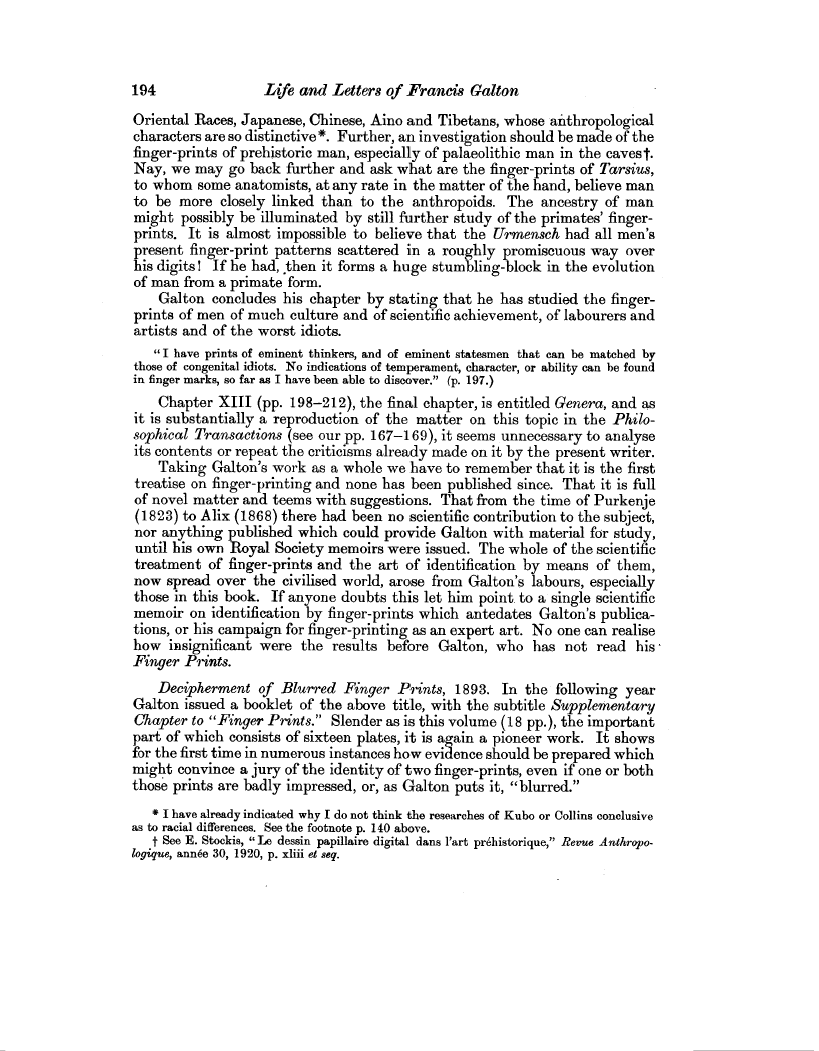| ||||||

OCR Rendition - approximate
194 Life and Letters of Francis Galton Oriental Races, Japanese, Chinese, Aino and Tibetans, whose anthropological characters are so distinctive *. Further, an investigation should be made of the finger-prints of prehistoric man, especially of palaeolithic man in the cavest. Nay, we may go back further and ask what are the finger-prints of Tarsius, to whom some anatomists, at any rate in the matter of the hand, believe man to be more closely linked than to the anthropoids. The ancestry of man might possibly be illuminated by still further study of the primates' fingerprints. It is almost impossible to believe that the Urmensch had all men's present finger-print patterns scattered in a roughly promiscuous way over his digits! If he had, then it forms a huge stumbling-block in the evolution of man from a primate form. Galton concludes his chapter by stating that he has studied the fingerprints of men of much culture and of scientific achievement, of labourers and artists and of the worst idiots. " I have prints of eminent thinkers, and of eminent statesmen that can be matched by those of congenital idiots. No indications of temperament, character, or ability can be found in finger marks, so far as I have been able to discover." (p. 197.) Chapter XIII (pp. 198-212), the final chapter, is entitled Genera, and as it is substantially a reproduction of the matter on this topic in the Philosophical Transactions (see our pp. 167-169), it seems unnecessary to analyse its contents or repeat the criticisms already made on it by the present writer. Taking Galton's work as a whole we have to remember that it is the first treatise on finger-printing and none has been published since. That it is full of novel matter and teems with suggestions. That from the time of Purkenje (1823) to Alix (1868) there had been no scientific contribution to the subject, nor anything published which could provide Galton with material for study, until his own Royal Society memoirs were issued. The whole of the scientific treatment of finger-prints and the art of identification by means of them, now spread over the civilised world, arose from Galton's labours, especially those in this book. If anyone doubts this let him point. to a single scientific memoir on identification by finger-prints which antedates Galton's publications, or his campaign for finger-printing as an expert art. No one can realise how insignificant were the results before Galton, who has not read his Finger Prints. Decipherment of Blurred Finger Prints, 1893. In the following year Galton issued a booklet of the above title, with the subtitle Supplementary Chapter to "Finger Prints." Slender as is this volume (18 pp.), the important part of which consists of sixteen plates, it is again a pioneer work. It shows for the first time in numerous instances how evidence should be prepared which might convince a jury of the identity of two finger-prints, even if one or both those prints are badly impressed, or, as Galton puts it, "blurred." * I have already indicated why I do not think the researches of Kubo or Collins conclusive as to racial differences. See the footnote p. 140 above. t See E. Stockis, " Le dessin papillaire digital dans fart prehistorique," Revue Anthropologique, annee 30, 1920, p. xliii et seq.
|